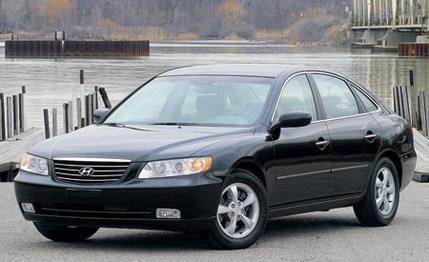 Short Take Road Test
Short Take Road Test
Korean automakers don't build sports cars. The closest they've come is Hyundai's Tiburon, and that effort is not really close at all. Instead, the Koreans have concentrated on building sedans and sport-utility vehicles that work as advertised and are steadily improved with each new generation. Hyundai must be scrutinizing the competition and pulling all-nighters, because the improvements of late have been startling and swift. On the subject of swift, when we strapped our test equipment to the $25,080 Hyundai Azera, we discovered it has the highest top speed and accelerates quicker than any other Korean car we've tested.
We were surprised, because the Azera has a nondescript look to it, especially when shod with the 16-inch wheels that come on the base SE version. The sheetmetal blends American, Japanese, and Korean styling elements in a nearly cohesive, if slightly dull, way. From the plain look of it, one would never suspect the Azera is capable of running from 0 to 60 in 6.1 seconds and turning a quarter-mile in 14.8 seconds at 96 mph. Those numbers make the Azera just 0.1 second slower to 60 and 0.2 slower in the quarter than last year's comparo-winning Toyota Avalon ["$30,000 Family Sedans," July 2005]. Or you could think of the Azera as being as quick to 60 as a BMW 325i.
The source of the Azera's speed is an emboldened 263-hp, 3.8-liter version of Hyundai's 3.3-liter DOHC V-6. Although it's down five horses from the Avalon's rerated 268-hp V-6, Hyundai's larger-displacement 3.8-liter makes more torque. Coupled to the engine is a five-speed automatic that does its job smoothly and unobtrusively but did show some reluctance to downshift. We found no sign of torque steer, nor did the front tires have to fight for traction. Disappointingly, we only achieved 15 mpg over some 400 miles of highway and city driving - far short of the Azera's 19 city and 28 highway EPA numbers.
Despite the eager and thirsty engine, the rest of the package doesn't exactly encourage one to search out twisty back roads. Steering feel is on the numb side yet accurate enough not to be considered sloppy. The Azera doesn't suffer from mirror-scraping body roll, but neither does it turn in like Fernando Alonso's Renault. Let's just say it's flatter than a Kia Amanti's handling profile, a car that an American Kia official once described - quite privately - as the Korean Packard. What the Azera provides is space, a degree of pace, and a chassis more concerned with comfort than sport.
Although the latest Toyota Avalon is sportier than its predecessors, the Azera (ostensibly a replacement for the chrome-laden Korean-to-a-fault XG350) feels and acts a lot like what we've come to expect from an Avalon, Buick, or even Lexus ES350. Just confine the Azera's task list to around-town errand boy, cruising the interstate, and picking up relatives and their junk at the airport, and it will shine.
The structure is essentially a long-wheelbase version (the wheelbase has been stretched two inches) of the mid-size Sonata unibody architecture. The extra length provides a spacious and comfortable back seat as well as a 16.6-cubic-foot trunk. At highway speeds the cabin is isolated and serene (we recorded a low 66 decibels at 70 mph). It's more quiet inside at that speed than an Avalon or even the last Cadillac STS we tested.
The cabin has all the luxury-car cues: tightly grained plastics, a band of fake wood that wraps around the dash and cabin, multiple shades of beige, and switchgear that has a Lexus-like look, if not feel, to it. About the only gripes we had with the interior were the econocar-like gauges and the not-quite-terry-cloth-but-definitely-not-Alcantara seats. Kick in $2500 for the Limited model, and things improve by way of heated leather seats, 17-inch wheels, and electroluminescent gauges. Go without, and you'll still get airbags galore, stability control, automatic climate control, and the bragging rights that come with Korea's fastest car.